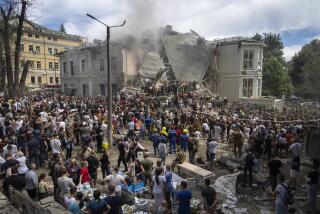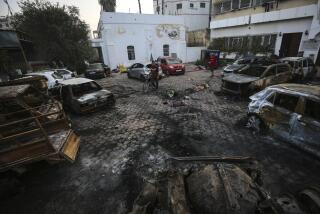NATO Bombs Civilian Bus, Causing Scenes of Horror
- Share via
LUZANE, Yugoslavia — A NATO airstrike blew a civilian bus in half Saturday afternoon on a bridge in this Kosovo village, killing at least 24 people and critically wounding 16 others.
At least four of the victims were ethnic Albanian children who had boarded the southbound bus in the Serbian province at Podujevo, a once-deserted town six miles up the road where more than 50,000 refugees had returned only 11 days earlier.
A statement issued early today at NATO military headquarters in Brussels confirmed the attack on the bridge, which the statement termed part of “a key north-south supply route for Yugoslav military and special police operating between Pristina and Podujevo in Kosovo.”
“Unfortunately, after weapon release a bus crossed the bridge,” NATO said, adding that the alliance “is not in a position to confirm civilian loss of life.”
NATO bombs have mistakenly struck civilians at least five times since the air war began; alliance officials have expressed regret for what they call “collateral damage” but say Yugoslav President Slobodan Milosevic is to blame for provoking the bombing.
As ambulances raced to and from the bus’ burning wreckage, half of which fell about 60 feet to a riverbank below, a fighter-bomber struck again with two bombs that hit a short bridge at Jug Bogdan, about two miles away.
A small group of journalists was about 300 yards from the second bridge when a bomb exploded in a ball of orange flame. They watched another detonation minutes later when an ambulance was trying to cross.
Shrapnel from that blast wounded a civilian medical technician in the forehead and prevented other ambulances from reaching the carnage at the destroyed bus, where mangled bodies included the severed arm of a small child.
The limb was barely a foot long, and it lay among the corpses below the bridge in a grassy field where spring daisies were in full bloom. The rest of the child’s body was nowhere to be found.
A North Atlantic Treaty Organization jet attacked the bridge, which is less than 300 feet long, about 1 p.m. when the bus was heading south from the Serbian city of Nis to Pristina, Kosovo’s provincial capital.
“I heard a plane and then the explosion, and everything started to burn,” Flamur Behluli, 15, said in Pristina’s main hospital as a Kosovo Albanian nurse translated. “I don’t know how I got out of the bus and reached here.
“The bus was full of civilians, most of them old people and children,” he said. “There were two or three soldiers.”
And then the boy, his arms wrapped in bandages and his face speckled with small cuts, had a question for the nurse.
“Can you tell me something about my sister?” he pleaded, but she didn’t answer.
Two of Flamur’s sisters lay in hospital beds just a few feet away. Egzona Behluli, 8, suffered burns to several parts of her body.
The other sister, Adulena, 12, was in the bed by the door, and both her arms were wrapped in bandages. A badly burned fourth child, much younger, was in the room too.
Four hours after the attack, all available surgeons and medical technicians at the Pristina hospital were in operating rooms trying to save the lives of the survivors that ambulances had managed to reach.
“Each of the 16 patients has serious wounds caused by blast syndrome--second- and third-degree burns as well as massive limb fractures,” Dr. Rade Grbic, the hospital’s director, said later.
At least 40 people were believed to be riding in the bus that was destroyed Saturday, but the number of casualties might never be known because highway bus companies don’t normally keep passenger lists. Tanjug, Yugoslavia’s official news agency, reported that 40 people had been killed.
Because NATO’s bombing campaign has destroyed oil refineries and fuel storage depots across Yugoslavia, most buses are running full of passengers who might have made their trips in cars if gas wasn’t being rationed.
Saturday’s bombardment caused only minimal damage to the bridge, where the blast took out a piece about 9 feet long and 3 feet wide at the very edge of one lane.
Even if the strike had hit its target squarely, and destroyed the bridge instead of a bus, it wouldn’t have stopped traffic along the road because another route adds only a matter of seconds to the trip.
About 1:25 p.m., two ambulances sped through the center of Pristina toward the wreckage, and 25 minutes later five ambulances sped near the Jug Bogdan bridge en route to the Pristina hospital.
A bomb exploded on that bridge at 1:51 p.m., and when a civilian ambulance tried to cross along a smaller, parallel bridge at 1:55 p.m., a second bomb struck.
The explosions hit both sides of the bridge but took only small bites from the very edges, so the intended target escaped serious damage. But the heavy blasts blew out the ambulance’s windows, smashed in its roof and injured one member of the medical team inside.
Another ambulance rushing some of the wounded from the destroyed bus had to stop and pick up the medical technician bleeding from his forehead, along with a doctor and driver, who subsequently had to get into a civilian’s car to reach the hospital.
After the second bombing run, NATO jets returned again, and although they held their fire, the sound of jet noise was enough to force ambulances to stop and wait, losing crucial minutes in the race to save survivors.
Meanwhile, fire spread through the broken sections of the bus, which had almost made it across the bridge when it was struck at least once. The blast snapped off the back half, which tore out a section of guardrail and fell to the field below.
NATO’s daily slow-motion replays of air attacks videotaped from a pilot’s-eye view high above the targets might leave the impression of a bloodless war fought with “smart” bombs.
This is what Saturday’s attack looked like from the ground:
The explosion threw a passenger’s arm at least 75 yards from the bridge. From the slender fingers and long, polished nails, it was obviously a woman’s.
Closer to the bus’ rear section, mangled pieces of passengers’ bodies lay twisted among bent window frames, seat cushions and luggage. One piece of luggage was a black carry-on bag with the label USA 1902 Russell Athletic stitched across the top.
It was full of cartons of Lucky Strike cigarettes, a cherished commodity in Yugoslavia because NATO blew up one of the country’s largest cigarette factories weeks ago.
Two of the corpses were in military uniforms, one of which was the olive drab of a reservist.
Around the severed child’s arm that lay alone were the things a mother might pack for a short journey. There were onions and boiled potatoes, bags of ground coffee and orange-flavored Vitamin C tablets, and 70 German marks that might have blown away if they hadn’t been weighed down by mud.
Beside the bus wreckage, a small, crackling fire was slowly consuming three bodies, two of which were lying on their backs with fists raised, as if grasping at the air.
Under the bridge, a few yards from a jar of Nivea cream, a bottle of hair spray, a deck of cards and a TV remote control, there was a small crater.
Two aluminum fins from whatever was fired at the bridge were stuck in the ground along with broken pieces of a circuit board, the same telltale signs found after other NATO airstrikes across Kosovo.
NATO’s bombing continued well into Saturday night and frequently shook the Pristina hospital even as frantic people gathered to see if any of their relatives were wounded or killed in the bus.
One woman, in tears at the hospital’s gate around 5 p.m., thought her son might have been a passenger because he left the bus station in Belgrade, the capital of Serbia and Yugoslavia, at 9 a.m. Long after he should have arrived in Pristina, his mother couldn’t find him.
As the woman left for home, knowing no more than when she had come, a bang made everyone look up at the sky, where a Yugoslav surface-to-air missile burning yellow left a trail of gray smoke.
Another fired, and then a third, while a NATO fighter plane did several barrel rolls high overhead and then disappeared, apparently untouched. The Yugoslav missiles had missed their mark too.
*
Time staff writer Carol J. Williams in Brussels contributed to this report.
All of Paul Watson’s dispatches from Kosovo are available on The Times’ Web site at https://www. latimes.com/dispatch.
More to Read
Sign up for Essential California
The most important California stories and recommendations in your inbox every morning.
You may occasionally receive promotional content from the Los Angeles Times.













